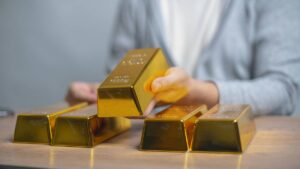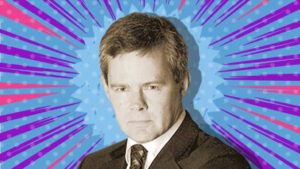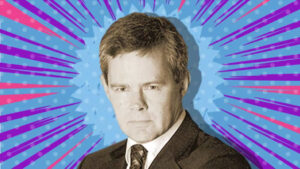Five or so questions for Genesis Minerals MD Raleigh Finlayson

Pic: Schroptschop / E+ via Getty Images
- Goldfields boy Raleigh Finlayson is back at the helm of a local explorer in Genesis Minerals
- Finlayson led Saracen and then Northern Star after the Super Pit owners’ $16 billion merger in 2020
- Genesis plans to release a roadmap this week to make up the $5 billion value gap to Australia’s golden mid-tier
Raleigh Finlayson grew up on Jeedamya Station near Menzies, a largely forgotten town on the Goldfields Highway 130km north of Kalgoorlie-Boulder.
His family lineage and upbringing brought him into the mining game after a stint at boarding school in Perth.
Uncles Chris and Peter Lalor ran Sons of Gwalia, a famous gold business that thrived from the 80s to the early 2000s before bad hedging arrangements sunk the company.
The descendants of Eureka Stockade leader Peter Lalor, they gave Raleigh his first start in the mining game before he trained at Kalgoorlie’s WA School of Mines as a mining engineer.
While connections no doubt helped (Finlayson’s sister Marnie is also the head of Rio Tinto’s lithium and borates division), Raleigh has struck out on his own and then some.
In his late 20s, Finlayson left a comfortable job at a Kambalda nickel mine to become a mine manager (and later MD) at Saracen Mineral Holdings, a small $30 million capped explorer trying to restart the once Sons of Gwalia owned Carosue Dam gold mine near Kalgoorlie in 2008.
Within a decade it was a multi-billion dollar mid-tier gold miner with $1.1 billion to blow on half of Kalgoorlie’s enormous Super Pit gold mine.
He eventually became managing director briefly of Northern Star Resources (ASX:NST) after the Super Pit JV partners merged to form what was at the time a $16 billion gold company in late 2020.
But Finlayson left that role, went on to study at Harvard Business School and plotted a return to his natural home in junior exploration at Genesis Minerals (ASX:GMD).
Having brought almost $21 million in new funding on board when he joined the explorer last year (along with border hopping former Fortescue CEO Nev Power, who seems to be laying low for now) Finlayson is targeting a repeat of the Saracen story in a similar domain.
Previously touted as a long-term takeover target for Gwalia gold mine owner St Barbara (ASX:SBM), Genesis owns the Ulysses gold project and a host of other prospective deposits around the Menzies and Leonora gold districts, around where Finlayson was raised.
A resource update last week boosted its gold resources by 400,000oz to the 2Moz mark comprising 39.3Mt at 1.6g/t, including 562,000oz at Admiral, 302,000oz at Orient Well, 838,000oz at the Ulysses deposit and 310,000oz at Puzzle, including a maiden 232,000oz resource for the encouraging Puzzle North discovery.
It’s a good time to add ounces as well, with geopolitical uncertainty following Russia’s war with Ukraine heightening the flight to safe haven investments and pushing gold prices to US$1934/oz ($2587/oz Aussie).
This week Finlayson plans to launch Genesis 2.0, a roadmap for the junior’s future growth plans designed to bridge the $5 billion gap to Australia’s biggest gold miners.
In many ways it appears to be an attempt to recreate Finlayson’s first success at Saracen, though only time and the drill bit will tell.
We caught up with Finlayson last week to ask him five or so questions on his plans for the $430 million market cap explorer, up 180% since his announcement as MD was made public in October last year.
Genesis Minerals share price today:
You’ve got the Genesis 2.0 launch coming up, but it sounds like you’re almost putting together Saracen 2.0. Is that a good way to look at it?
“It’s a blend mate. So definitely attributes of Saracen particularly around values and vision and bits and pieces, but we can’t ignore that Genesis in its own right’s a decade long (company) and has been very successful.
“So it’s not a complete rebrand. But it’s a combination with probably a leaning towards some of the Saracen attributes which have held us in good stead, and people have done well out of.”
What’s the general flavour of that brand? I know you were pretty reluctant to tell anyone before it came out on the market?
“There’s some things around cultural stuff, like I talk about my vision and values and how we’re gonna go around people and culture.
“But then there’s more meatier stuff around where we see our growth pillars, and how we are going to value those things, what stages we might go through, and ultimately where we want to get to.
“So there’ll be certainly some meat on the bone, which obviously we can’t talk about ‘til it’s released on Monday.
“But there’s some what they call softer issues, which are more around how we do it and why we do it, which by and large, coming from the Saracen flavour. But the beauty of having 22 people in our entire workforce, every single one of those people have been engaged and their inputs driven this. So it’s not a top down process, it’s very much bottom up.
So you were working with Bill Beament in your latter days at the Super Pit JV and then on the Northern Star board itself. He came out at Diggers and Dealers last year and said ‘gold isn’t green’. What was your take on those comments?
“Bill’s obviously been in gold for a very long period of time and just stepped out of it. So I don’t read too much into it. But end of the day, look obviously, there’s a bunch of other commodities that are forward facing views for the future and those sorts of things.
“And absolutely, they have their place and they’re all working towards, you know, making the world a better place to live in. Obviously, gold has its purpose fundamentally as much as a currency as anything else so they’re quite different spectrums and I take it in my stride I suppose.”
AngloGold boss Alberto Calderon actually had a talk at the Melbourne Mining Club last week where he said gold should be in your portfolio if you’re ESG friendly.
“Yeah, absolutely. You try and compare against some crypto and we’re in far better shape. But we can’t lose sight of that, obviously in mining, all of these future metals also produce carbon emissions.
“So in my mind, it’s about working towards net zero, which I think the big golds are already on the front foot on and as soon as we work out our development plans we’ll be articulating those as well.
“Regardless of what commodity people are in I commend those miners that are on the front foot and I look at companies like Gold Fields at Agnew and what they put in there from renewables is fantastic. That’s a really good, in my mind, leader in the space and they’re a gold miner.”
Genesis before you got involved in the company, it looked like the little fish that was about to get swallowed by St Barbara. Is that completely off the table now that you’re in the company?
“Oh, look at the end of the day we haven’t really been too focused on that. We spent most of our time in the last few months, albeit I only started in February, planning around our own business and understanding exactly what where we’re at and where we can take it.
“And then obviously, we’ll become more inquisitive about the neighbourhood. So you know, we’ll have two streams, there’ll be an organic stream, there’ll be an exploration stream, and there’ll be an M & A stream that we’ll sort of provide a bit more colour on next week.”
And you spoke about wanting to make up that $5 billion value gap to the large cap gold companies from where you are currently. Do you need to have big acquisitions to be part of that or could you achieve that from what you’ve got yourself? It’s quite a small resource at the moment.
“Yeah, I mean it’s funny. When we started at Saracen back when all we had was Carosue Dam, we had a $32 million market cap, had zero reserves, 600,000 ounce resource when I got there in 2008. We got it into production 2010.
“So it’s was a combination of really good discovery costs at the likes of Karari and Thunderbox, then some really good M & A, the bottom of the cycle stuff like Thunderbox and King of the Hills.
“So we were able to take Saracen from a $30 million market cap into what we dubbed then the G5.
“There was four (mid-tier Australian gold) leaders and we created the vernacular of G5 or at least Troy Irvin did (Saracen corporate development head).
“And we put ourselves in that bracket where we wanted to be referred to in that mid cap space, and we worked really hard towards that.
“It was a combination of organic and inorganic, I think the reality is it will probably be something similar to fit this vision (at Genesis) as well.”
Do you have an idea yet on what you’re going to be spending on exploration to get to that reserve?
“So we’ve been running at about a million dollars a month. That’s $12 million a year. And that’s seen that growth in the last reporting period of 400,000oz of discovery.
“So if we see the exact same spend, the exact same growth we’ll be at 2.4Moz all things being equal. Obviously Puzzle’s pretty new on the picture so that has some scope to move quickly, as we have discovered it and extended it.
“So I would argue a similar spend will get us there, and we’re around $23 million in the kitty, there are some options in the money which will bring in another $25-30m.
“So we’re going to be well funded to do that plan. And we’d expect to see resources to grow, we’ll start working on building up some reserves off a zero base, and then we’ll continue to try and find more discoveries. So it’s a three-way attack.”
Last one – you said the seat that’s been kept warm for you at Northern Star, that’s going to get cold. You’re not rejoining the board there. What made you want to focus so much on Genesis rather than move into those board, investment sort of positions that a lot of retired MDs do?
“I suppose a few things. One is I’m 43, so I’m not quite retirement age. Secondly, anyone that knows me well enough I’m just a technical sort of engineer, typical sort of boffin in lots of ways.
“I found towards back end of Saracen, and moving into Northern Star, it just got a lot bigger and had a massive workforce, I didn’t get to do the fun stuff.
“When we bought the Super Pit and we did the merger with Northern Star we spent a lot of time on site at the Super Pit. And that was most probably the most enjoyable period short of the very early stages of Saracen for me. I sort of reflected on that and just wanted to go back down the curve again.
“So now I’m back into using surpac and doing pit designs and optimisations and I’m having a buzz.
“For me, that going down the curve it’s just a lot more fun. When you find yourself in a bigger organisation with more people, you focus yourself in different areas. I was sort of feeling like more of a generalist MD as opposed to a technical engineer, which is what my background is. So that was a no-brainer for me.
“As far as stepping off or not coming back onto the board. Obviously in the last three or four months we’ve been articulating our growth strategies and had a really mature conversation with Mr Cheney (NST chairman Michael Chaney) and (Northern Star MD) Stuey Tonkin.
“I said look there’s a risk that in short order or medium order that being in the gold space, we’re small at the moment and you’re the biggest miner in town and eventually being in the same district we could be creating conflict.
“I didn’t want to be in a position where I’m stepping on the board and then having to step off for conflict reasons. So that made sense, but to be really clear I’m a massive supporter of the company, still a shareholder. I’m a massive supporter of Stuey and Michael to take the business forward so we’re still remaining very close.”
Related Topics

UNLOCK INSIGHTS
Discover the untold stories of emerging ASX stocks.
Daily news and expert analysis, it's free to subscribe.
By proceeding, you confirm you understand that we handle personal information in accordance with our Privacy Policy.








